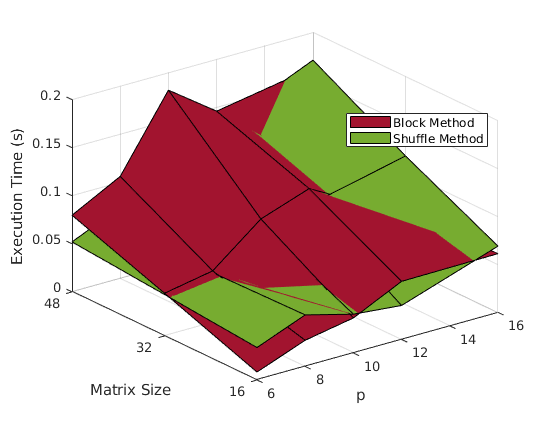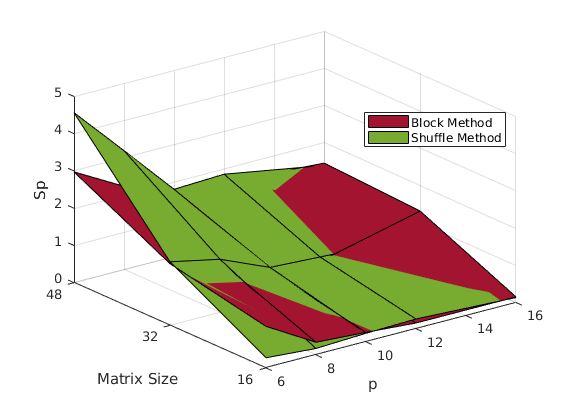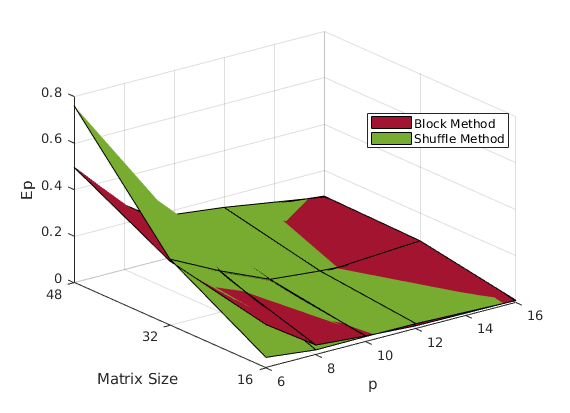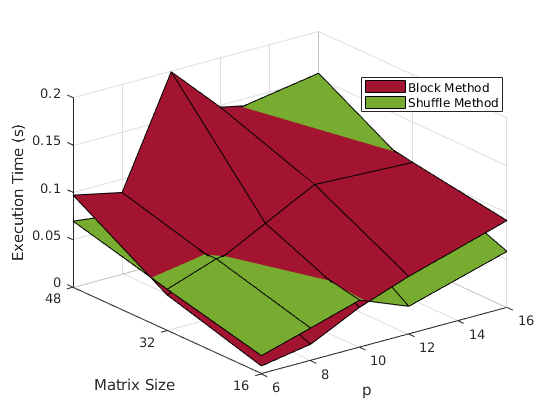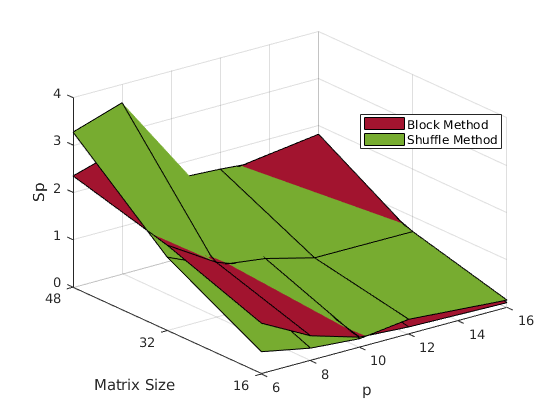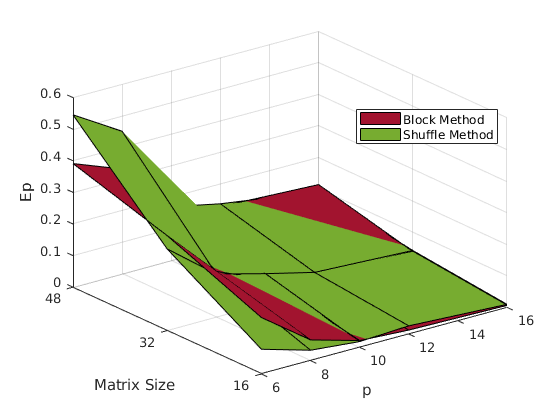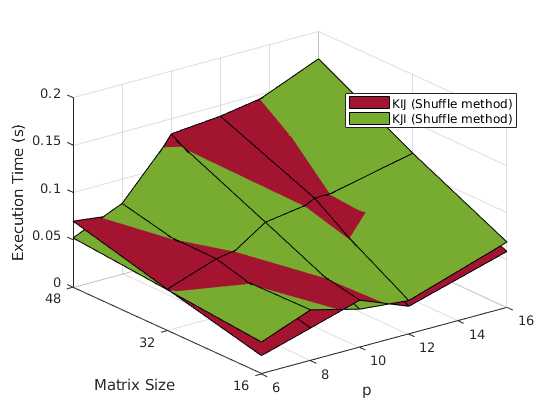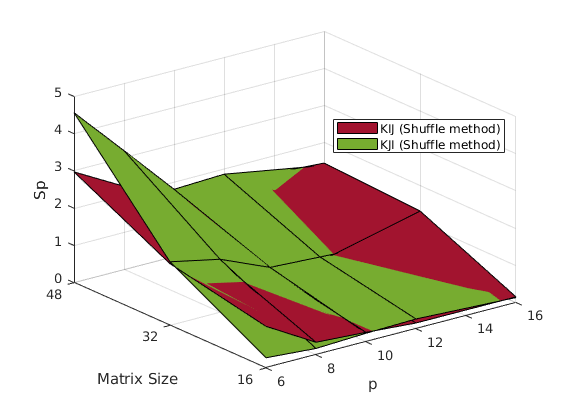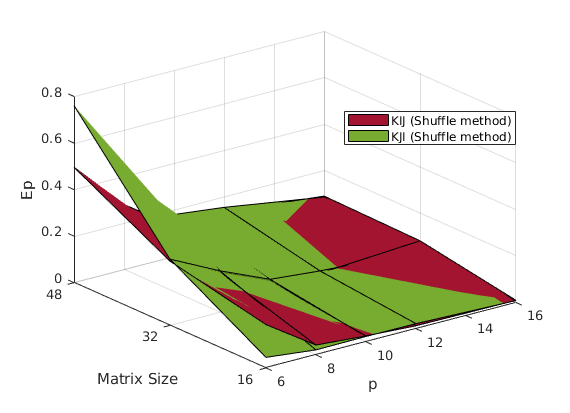Python scripts that implement the (parallel and serial) KIJ and KJI Gauss Jordan elimination methods to solve a linear system of equations.
Gaussian elimination is a neat way to solve linear systems of equations. Typically, it goes like this:
# Solving Ax=b using Gaussian elimination with partial pivoting
# Input: A: n x n matrix, b: vector of n dimensions
# Output: x: vector of n dimensions
Afull = stack(A,b) # A is now n x n+1, as we append b as a new column
for k=1:n do # traverse through columns of A
# Find pivot (largest element of active column)
pivot = Afull[k][k]
pivot_row = k
for i=k+1:n do
if Afull[i][k] > pivot:
pivot = Afull[i][k]
pivot_row = k
# Swap k-th row with row with the pivot element
swap(Afull,k,pivot_row) # Afull[k][k] is now the pivot
# Update bottom-right part of matrix
for i=k+1:n:
m = A[i][k]/A[k][k]
for j=1:n+1 do:
Afull[i][j] = A[i][j] - m*Afull[k][j]
# After this, A should be in upper diagonal form.
# Solving for x:
x[n] = Afull[n][n+1]/Afull[n][n]
for i=n-1:1 do:
sum = 0
for j=i+1:n do:
sum = sum + Afull[i][j]*x[j]
x[i] = (Afull[i][n+1] - sum ) / Afull[i][i]
# x now contains the solution of the system.This algorithm has complexity of . However, execution time may be reduced by using parallelization.
The result of the Gauss elimination is a matrix in upper diagonal form. In each step the bottom-right part of the matrix is updated. If we replace the # Update bottom-right part of matrix step with the following:
# Update right part of matrix
for i=1:n, i != k:
m = A[i][k]/A[k][k]
for j=1:n+1 do:
Afull[i][j] = A[i][j] - m*Afull[k][j]
we end up with Gauss-Jordan elimination. Notice that we now update all of the rows, not just those rows "under" the active the pivot. The result of Gauss-Jordan elimination is a matrix in diagonal form.
There a ton of ways to parellilize this method, two of which are presented in this repo. The main idea behind these methods is to assign a number of columns to each available processor, so that the computation of the bottom right part will happen in parellel. Of course, the task of selecting a pivot row will be processed by the processor responsible for the respective column.
My implementation of the both the KJI and KIJ methods can be summed up in this pseudocode:
# This code is run in parallel by every processor.
# In order to avoid actuall swaps and save time, a pivot array is used.
# In short, it contains indexes of lines i.e. if pivot[0] is equal to 3,
# it means the line 3 is first.
for i=0:n:
if I am responsible for the k-th column:
# Find pivot
pivot_pos = find_pivot(A,k)
swap(pivot,pivot_pos,k)
# Inform processors with columns after me about the swap
for proc in next_procs:
comm.Send(pivot)
# Update my columns
update_cols(A)
# Send my columns to the next processors (next as in processors
# that are responsible for columns with larger index than me)
for proc in next_procs:
comm.Send(update_cols)
# Receive cols from other processors
for proc in next_procs:
comm.Recv(updated_cols)
update_cols(A,updated_cols)
else:
# If this processor is not resonsible for any columns with larger
# index than the active, then it is no longer needed.
if k > max{col_indexes_that_i_am_resonsible_for}:
exit()
# Receive updated pivot array
pivot = comm.Recv(pivot)
# Update my columns
update_cols(A)
# Send columns to the next processors
for proc in next_procs:
comm.Send(update_cols)
# Receive cols from previous processor (if they exist)
for proc in next_procs:
comm.Recv(updated_cols)
update_cols(A,updated_cols)One can easily note the three main for-loop variables used during the "update my columns" step: i,j and k. The names of the methods come from the order of the loop variables in the for-loops of the algorithm:
for k in range(0,n):
.
.
.
for j in column_mapping[myrank]:
if j > k: # We have to do calculations for columns right of the active column
Afull[pivot[k]][j] = Afull[pivot[k]][j] / Afull[pivot[k]][k]
for i in range(0,n):
if i != k :
Afull[pivot[i]][j] = Afull[pivot[i]][j] - Afull[pivot[i]][k] * Afull[pivot[k]][j] for k in range(0,n):
.
.
.
for i in range(0,Afull.shape[0]):
if i != k: # no need to update the column that the pivot is in
for j in column_mapping[myrank]:
if j > k: # update columns right of the active column
Afull[pivot[i]][j] = Afull[pivot[i]][j] - Afull[pivot[i]][k] * Afull[pivot[k]][j]
Two columns assignment methods have been implemented:
-
Block method: Each processor is assigned
consequtive columns.
-
Shuffle method: The columnd of the input matrix are "dealt like cards" to processors. Lets say, for example, that A is a 10 by 10 matrix and we have 4 processors available:
| Processors | Processor 1 | Processor 2 | Processor 3 | Processor 4 |
|---|---|---|---|---|
| Assigned Columns | 1,5,9 | 2,6,10 | 3,7,11* | 4,8 |
*Remember that we append vector b to A, thus increasing the total number of columns by 1.
In order to assess the performance of the implementation, 3 metrics will be used:
It should be evident by now that the shuffle method performs better. Although the block method is easy to understand and implement, after a while, it leaves most of the work left to the processors assigned columns with higher indices, thus creating a bottleneck.
The KIJ methods seems to perform a bit better (at least on the example data).
